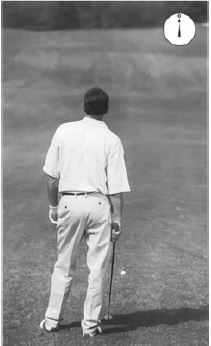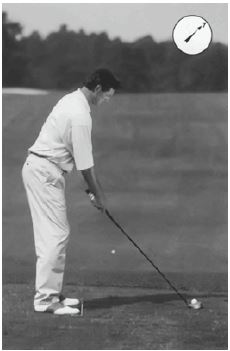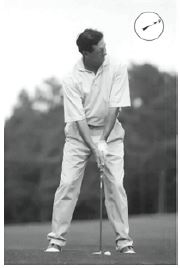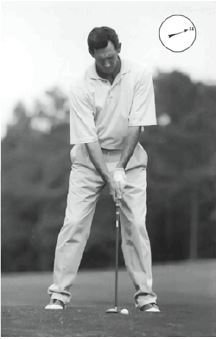Proper Golf Posture - Fix Your Swing | Achieve the ideal wrist, elbow, and arm position
The First Thing
Why is the posture inaccurate? The posture you create at address is often not the posture you have at impact. It's very much a feeling. You want a consistent starting point, but are you getting to that place? Do you want to do that? Only if you have a correct swing plane. Your posture is the one place where you can adjust the plane for you if you have to. This is why it is not an exact science. Most people don't swing on a perfect plane. If you don't, you don't need or want an ideal posture.
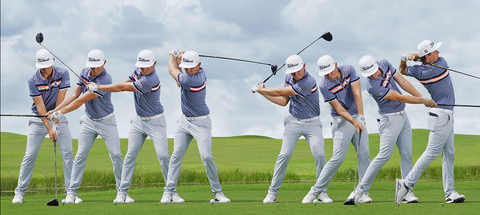
The best way to check is to look in the mirror. Get some sequence photos of top players from Golf Digest and try to pose like Mark O'Meara or Nick Faldo. Your worst-case scenario is very close to your perfect pose. It doesn't have to be exact. So, could you not get too hung up on it?
There isn't just one way to do things. Let's say you come to me to hook the ball. I might have you stand with your right foot pointing straight ahead and your left foot pointing out more to get your body turned around more (see diagram).
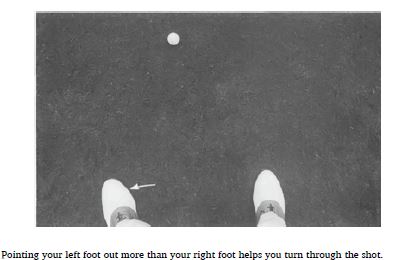
Again, you might be slicing the ball. Let's say that your upper body is too far ahead of your lower body, leaving the club behind and the clubface open. With these factors in mind, I might lean my right foot out a little, as opposed to the person who hooked the ball and leaned your left foot in (see diagram). Still leaning outward a little, just not as much. This will allow you to turn on the backswing and encourage more hand and arm action through the impact.
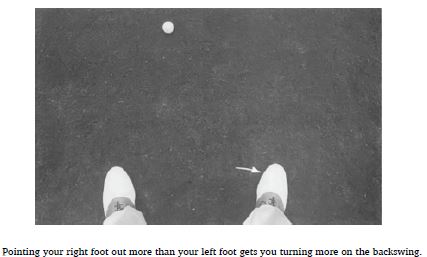
There are also a few minor adjustments you can make. If you put the club too much on the inside on the backswing, I can move your hands back a little bit on the stroke. This will encourage the club to move away from the ball more from the outside. If you tend to bring the club back out of the plane, I might move your hand forward at the address. All of this is to get the early part of your swing moving more around your body.
Again, be flexible. Let's say you bring the club to the outside, above the plane. And your hand is in front of the ball at the address. This would say, "Move your hand back a bit" because it looks better. However, it will move your club more to the outside. So don't change just for the sake of change. Any change has to have some effect on the golf club.
Change according to your reality. Not everyone is set up in the same position. There is some wiggle room in the address. There's not a lot of wiggle room; most great players look very similar. But you need to know what you're trying to fix before changing your address position.
Why You Get Out of Position
Most people start with a good setup, at least regarding their aim and body position. But as you hit different balls, your posture changes. If you often hit the ball behind the ball, it won't be long before you push your hands forward at address and put the ball back in your stance. You will close the club face at the address if you cut the ball to the right. The same goes for hooking the ball; the clubface will be open at the address (see diagram).
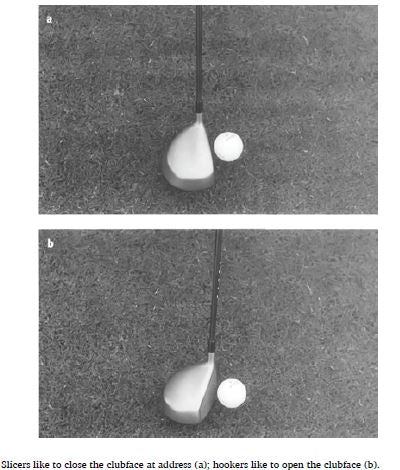
The height of the ball and the impact you create will often cause you to change your setup. It changes your aim. It changes the way you stand on the ball. So it is not enough to say that if you have a good setup you will hit a good shot, or that a lousy setup means you will hit a bad shot. However, a bad setup does make it harder for you to hit a good shot. You can still do that, but it probably won't last.
Then there's our old friend, the grip. A perfect grip is a grip that matches your swing. When you change anything in your game, you must try to maintain that ideal blend if you have hit some good shots or create a perfect blend if you haven't. Any change should have some impact on the flight of the ball. However, sadly, that's not what most teaching does. People change to change.
Your setup has only four critical aspects: posture, alignment, stance, and ball position.
Posture comes first because when the club hits the ball, your hands hold the club, which is attached to your arms and shoulders. So your posture has a direct effect on the plane of your swing. Your posture, on the other hand, does not. It may have an indirect effect - you may stand close and put the club in, or stand wide and put it out - but your shoulders are connected to your arms, so they have a direct effect. That's why posture is of paramount importance.
Posture
When you stand on the ball you need to bend forward from the hips so that your arms hang down from your shoulders (see picture). You should be in a comfortable position, but in a way that allows your arms to swing the club freely and allows your body to turn easily.

As I said earlier, the bend forward from your hips should be about 20 degrees. Your rear end should stick out and have a little up, but not too much. It should feel like a ready sporting position as if you were standing to weld a ground ball or shoot a free throw. Your weight should be directed towards the ball of your foot and evenly distributed to the left and right. Your arms hang gently over your shoulders. There should not be any forward slack in your shoulders. There should be no tension in your upper body, and your back should be reasonably straight.
Conversely, as your upper body turns during the backswing, your lower body should resist and be tense. Feel a slight tension on the inside of your legs, all the way down to your ankles. Your lower body will not initiate any movement during the backswing. Any motion should come from the rotation of your upper body pulling your lower body. This is why you need a solid base where your feet are almost fixed to the ground. Imagine if someone pushed you from any direction. If you don't fall over, you know you are well balanced (see picture).

All in one line. Draw a line down your back at an angle of about 20 degrees. Draw a line down the center of your body which should go right through your left eye (see picture).

This is as far as your posture needs to go to allow you to make a good swing. Good posture positively affects your swing, but here are a few to ponder.
If you bend forward too much from the hips, your shoulders will tilt more than they should as you swing, and the club will tend to swing too straight. If you stand too straight, your shoulders will turn too square and the club will tend to swing more than it should. The more you bend over, the lower your hands will be (see diagram). Lower hands will send the club to the outside (see diagram). The more you stand up, the higher your hand will be. A high hand will move the club too far to the inside.

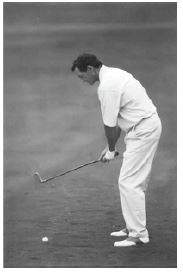
Alignment
Let's start by clearing up a common misconception. Aiming and alignment are not the same and are two different issues.
Aiming means aiming every aspect of your alignment at a specific target. Aligning means getting everything coordinated and pointing in the same direction. If something is misaligned, you will have a greater chance of making a mistake in your attack.
Having good alignment makes aiming easy, especially when hitting straight shots. You have to have good alignment to hit a good shot. But you don't need good aim. Proper aiming is getting your straight ball to a specific target.
Aiming is easy. If you don't believe me, ask a friend who has never played golf to take his club and aim at a distant target. I bet he'd do a great job. Beginners always do. They all aim at the target until they've hit a few strokes. Only then do they start to adjust. Let's say they chip the first three balls. Guess where they'll aim the fourth ball? That's right; to the left. All this compensates for the curve from left to right on the ball.
In contrast, with good alignment, you have a great chance of making a good swing and hitting a good shot. It may not be what you think you're aiming for, but it's still a good, solid shot. If you can do this consistently, you'll soon find your target.
Why is there so much confusion? Because there are so many teaching philosophies. Some teachers say that you can't hit straight if you can't aim. I think that if you can't hit straight, why would you aim straight? Also, if you hit a curve, each club will have a different curve. They all have a different loft, giving the ball a different degree of sidespin. Therefore, if you have a curvature problem, aiming is almost impossible.
Line up
Proper alignment is easy to describe. You want your feet, knees, thighs, hips, arms, shoulders, and eyes all aligned parallel to the left of the target. The bend in your right elbow makes up for the fact that your right hand is lower on the club than your left and closer to the ball, which keeps your shoulders and arms parallel to everything else.
The most critical aspects of alignment are the shoulders, arms, and eyes. Your feet are important but nowhere near as important as the rest of your body. Considering their relationship with the golf club, they get more attention than they deserve.
Your eyes have a significant impact on your swing. If you aim your eyes to the right, you may swing the club. If you tilt your head to one side, you may swing too steep or too far. You want to keep your eyes level with the ground and parallel to the target line (see diagram). This is important for your balance and the direction and angle of your swing. When you start to tilt your eyes, you run into balance problems, making it difficult to even place the club properly on the ground behind the ball, let alone hit it square.

Almost everyone who reverses their spin swings their club backward, so their eyes are at an angle, looking down at the ground. If their eyes stay level, they won't reverse spin. Use the brim of your hat or the top of your sunglasses to check how level your eyes are throughout the swing.
If you have watched Jack Nicklaus play golf for years, you may have noticed that he always aligns himself with an intermediate target a yard in front of the ball. The theory is that it is easier to align the clubface with a target this close as opposed to a target 200 yards away (see diagram). I like this approach.

Create Good Alignment
- Place one club on the ground and align your feet (see diagram).

- Hold the other club through your legs, just above your knees (see picture).
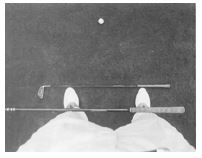
- Use the club on the ground as a reference point. When the two are parallel, your legs are aligned. Move the club upwards and place it across your hips to align (see diagram).
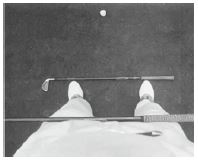
- Then your shoulders (see diagram) and eyes (see diagram). If your alignment is poor, you'll be surprised at how different you feel.
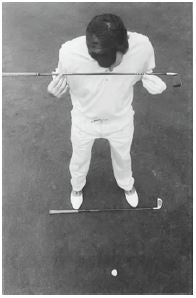

Now, pose for the ball. Your right hand is closer to the ball than your left. Your right elbow is bent. Please don't overdo it, though. I see many people tuck their right elbow tighter than they need to. This will only align your arm to the right, encouraging you to take the club away too much on the inside and then bring the club around on the downswing. Your arm should be parallel to the target line. If your right arm is fully extended, your arms will be lined up to the left.
So you're set up. Your right shoulder should be a little lower than your left shoulder - this is because your right hand is lower on the club.
You must align your body with the club face. The club face must be at the right angle to the line of your body. This is perfect alignment. Now you have given yourself a chance. A point of the passage. At the address, the toe of the club should be right on the ground. When you swing the club shaft bends in two ways; it arches downwards and backward. As the shaft bends downwards during the downswing, the angle of the club flattens out slightly. A proper club will therefore have the toe slightly upwards at the address (see diagram).
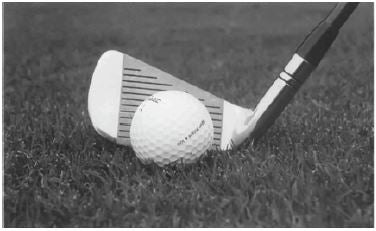
The Stance
Imagine that you are playing a 5-iron. At impact, your feet should be shoulder-width apart (see diagram).

Because you will eventually have to turn to face the target, your left foot should have a little more toe than your right foot. The right foot is squared off and just slightly turned out; the left foot is somewhat more. The position of these feet helps your lower body resist the backswing and enables you to turn into the follow-through.
However, there are variations, depending on the flight of your ball. The person hooking the golf ball usually may want to toe the left foot out a little more while keeping the right foot perfectly flat. They need to get their lower body moving as they swing forward, which helps.
Chippers may benefit from having the left foot toe in a little and the right foot out a little. This will also help make it easier if you try to shape the stroke. Adjust your stance to have Adjusting your stance would affect your body and thus your hands and arms, which in turn affect the club. But a certain stance certainly doesn't guarantee a certain shot shape. But it can help. And it's an easy adjustment to make.
Wider/Narrower
As the club gets longer, your stance will get broader. The widest and narrowest stances are no more than a few inches wide. It's a matter of perception.
Standing too wide will result in too much body movement. If you stand narrow, you will have more hand and arm swings. But if you do move your body, you will lose your balance.
When you widen your stance, you lower your center of gravity and move your center to the back of the ball. This will help you make more of a sweeping motion. The driver is the club you need the most help with in this area, as the ball is hit on the ground.
The closer you stand, the narrower your stance is, which is perfect for short irons. The further your center line is, the higher your center of gravity will be. All of this helps you to create more downward movement.
As you try to get the ball down, the chip shot will be your narrowest stance.
Ball Position
The club in your hand determines the ball's position in your stance.
On a driver, the shaft goes directly into the club head and the club face is in front of the shaft. So your hand has to be a little behind the ball (see diagram).

The 5-iron shaft is now slightly in front of the clubface. Your stance is narrower. You are teeing off with half your weight between your left and right foot, which may be 45-55 for the driver. But when you go into impact, most of your weight will be on your left side. This attempt to create an effect at address is not the right approach.
Therefore, for the 5-iron, the ball moves back. If you place the club head on the ground behind the ball, let the club be set the way it is, and then make a triangle with your hands and arms in front of your body, the ball will come to its correct position.
The ball will be the furthest back when you get to the sand bunker shot, the shortest club and the one with the most shaft in front of the club head. But it will still be in front of the center (see diagram). The ball will not move more than 2 or 3 inches throughout the set from the driver to the bunker shot. But it does change (see diagram)).
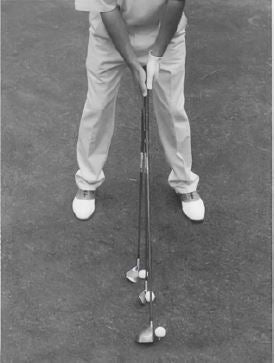

The constant in the setup is the triangle formed by your arms, hands, and shoulders. That stays the same. It doesn't change. The position of the ball changes because your club is different (see diagram).
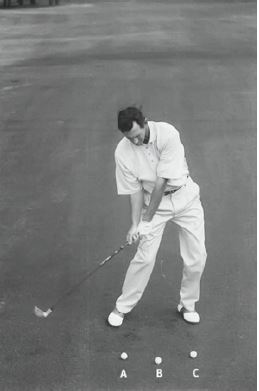
The Waggle
You are practicing your takeaway. It 'brings rhythm' to your swing and helps you get the rhythm and tempo right. When you shake the club, do it with purpose. Shake it on a flat surface. Shake it at an angle along the shaft, with the clubface slightly open.
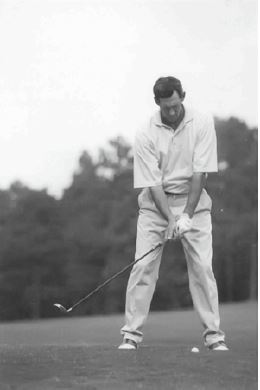
Use your hands to shake it. Not with your arms or shoulders. Soften your hands. Feel a slight upward cocking motion in your wrist and a little rotation in your left forearm and hand simultaneously. Feel a looseness to encourage fluidity in your swing. Practice bringing the club back to the plane. This is important.
PRE-SHOT ROUTINE
For a long time, this was one of the most neglected parts of the game.
Talking about the importance of a consistent pre-bat routine. What exactly are you supposed to do before adopting the address position in the last few seconds? How long should it take?
The best way to answer these two questions is to describe my pre-strike routine. This is not absolute, as we are all different. The key is to create a pattern for yourself that works for you. Then stick to it. Do this every time you hit the ball on the pitch.
My routine is like this. It takes 15 seconds from start to finish.
